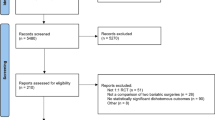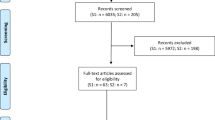Abstract
Objective:
This study identified the journals with the highest yield of clinical obesity research articles and surveyed the scatter of such studies across journals. The study exemplifies an approach to establish a journal collection that is likely to contain most new knowledge about a field.
Design and methods:
All original studies that were cited in 40 systematic reviews about obesity topics (‘included studies’) were compiled and journal titles in which they were published were extracted. The journals were ranked by the number of included studies. The highest-yielding journals for clinical obesity and the scatter across journal titles were determined. A subset of these journals was created in MEDLINE (PubMed) to test search recall and precision for high-quality studies of obesity treatment (that is, articles that pass predetermined methodology criteria, including random allocation of participants to comparison groups, assessment of clinical outcomes, and at least 80% follow-up).
Results:
Articles in 252 journals were cited in the systematic reviews. The three highest-yielding journals specialized in obesity, but they published only 19.2% of the research, leaving 80.8% scattered across 249 non-obesity journals. The MEDLINE journal subset comprised 241 journals (11 journals were not indexed in MEDLINE) and included 82% of the clinical obesity research articles retrieved by a search for high-quality treatment studies (‘recall’ of 82%). Of the articles retrieved, 11% were about clinical obesity care (‘precision’ of 11%), compared with precision of 6% for obesity treatment studies in the full MEDLINE database.
Conclusion:
Obesity journals captured only a small proportion of the literature on clinical obesity care. Those wishing to keep up in this field will need to develop more inclusive strategies than reading these specialty journals. A journal subset based on these findings may be useful when searching large electronic databases to increase search precision.
This is a preview of subscription content, access via your institution
Access options
Subscribe to this journal
Receive 12 print issues and online access
$259.00 per year
only $21.58 per issue
Buy this article
- Purchase on Springer Link
- Instant access to full article PDF
Prices may be subject to local taxes which are calculated during checkout
Similar content being viewed by others
References
Hedley AA, Ogden CL, Johnson CL, Carroll MD, Curtin LR, Flegal KM . Prevalence of overweight and obesity among US children, adolescents, and adults, 1999–2002. JAMA 2004; 291: 2847–2850.
World Health Organization. Obesity and overweight. [Online] September 2006. [Cited on 12 August 2008] Available from: URL: http://www.who.int/mediacentre/factsheets/fs311/en/
Wilczynski NL, Haynes RB, The Hedges Team. Developing optimal search strategies for detecting clinically sound prognostic studies in MEDLINE: an analytic survey. BMC Med 2004; 2: 23–27.
Arndt KA . Information excess in medicine: overview, relevance to dermatology, and strategies for coping. Arch Dermatol 1992; 128: 1249–1256.
Birken CS, Parkin PC . In which journals will pediatricians find the best evidence for clinical practice? Pediatrics 1999; 103 (5 Part 1): 941–947.
McKibbon KA, Wilczynski NL, Haynes RB . What do evidence-based secondary journals tell us about the publication of clinically important articles in primary healthcare journals? BMC Med 2004; 2: 33–46.
Burke DT, DeVito MC, Schneider JC, Julien S, Judelson AL . Reading habits of physical medicine and rehabilitation resident physicians. Am J Phys Med Rehabil 2004; 83: 551–559.
Weiner JM, Shirley S, Gilman NJ, Stowe SM, Wolf RM . Access to data and the information explosion: oral contraceptives and risk of cancer. Contraception 1981; 24: 301–313.
Royle P, Bain L, Waugh N . Systematic reviews of epidemiology in diabetes: finding the evidence. BMC Med Res Methodol 2005; 5: 2–7.
Montori VM, Wilczynski NL, Morgan D, Haynes RB, Hedges Team. Optimal search strategies for retrieving systematic reviews from Medline: analytical survey. BMJ 2005; 330: 68–73.
Garg AX, Iansavichus AV, Kastner M, Walters LA, Wilczynski N, McKibbon KA et al. Lost in publication: half of all renal practice evidence is published in non-renal journals. Kidney Int 2006; 70: 1995–2005.
World Health Organization. Obesity: Preventing And Managing The Global Epidemic: Report Of A Who Consultation On Obesity. [Online] 2008. [Cited on 12 August 2008] Available from: URL: http://www.who.int/nutrition/publications/obesity/en/index.html
NHMRC. Clinical Practice Guidelines For The Management Of Overweight And Obesity [Online] March 2004. [Cited on 12 August 2008] Available from: URL: http://www.health.gov.au/internet/main/Publishing.nsf/Content/obesityguidelines-guidelines-children.htm
Centers for Disease Control and Prevention. Defining overweight and obesity [Online] May 2007. [Cited 12 on August 2008] Available from: URL: http://www.cdc.gov/nccdphp/dnpa/obesity/defining.htm
Bickley SR, Harrison JE . How to….find the evidence. J Orthod 2003; 30: 72–78.
Haynes RB, McKibbon KA, Wilczynski NL, Walter SD, Werre S, Hedges Team. Optimal search strategies for retrieving scientifically strong studies of treatment from MEDLINE. BMJ 2005; 330: 1179–1184.
Acknowledgements
This research was funded by the US National Institutes of Health (National Library of Medicine) and the Canadian Institutes of Health Research.
Author information
Authors and Affiliations
Corresponding author
Ethics declarations
Competing interests
The authors declare no conflict of interest.
Additional information
Supplementary Information accompanies the paper on International Journal of Obesity website
Supplementary information
Rights and permissions
About this article
Cite this article
Baier, L., Wilczynski, N. & Haynes, R. Tackling the growth of the obesity literature: obesity evidence spreads across many journals. Int J Obes 34, 1526–1530 (2010). https://doi.org/10.1038/ijo.2009.268
Received:
Revised:
Accepted:
Published:
Issue Date:
DOI: https://doi.org/10.1038/ijo.2009.268
Keywords
This article is cited by
-
Motivation, self-determination, and long-term weight control
International Journal of Behavioral Nutrition and Physical Activity (2012)
-
Misuse of Odds Ratios in Obesity Literature: An Empirical Analysis of Published Studies
Obesity (2012)
-
Different effects of hyperlipidic diets in human lactation and adulthood: growth versus the development of obesity
Reproductive Biology and Endocrinology (2011)



